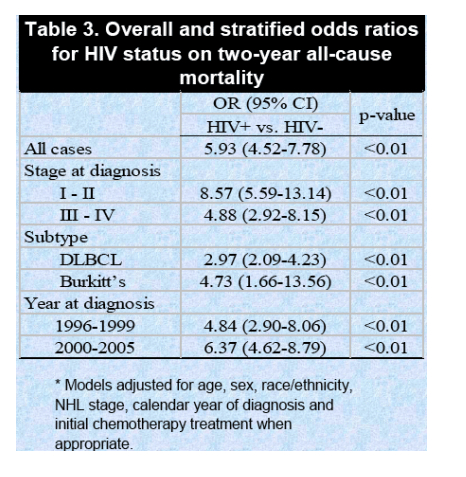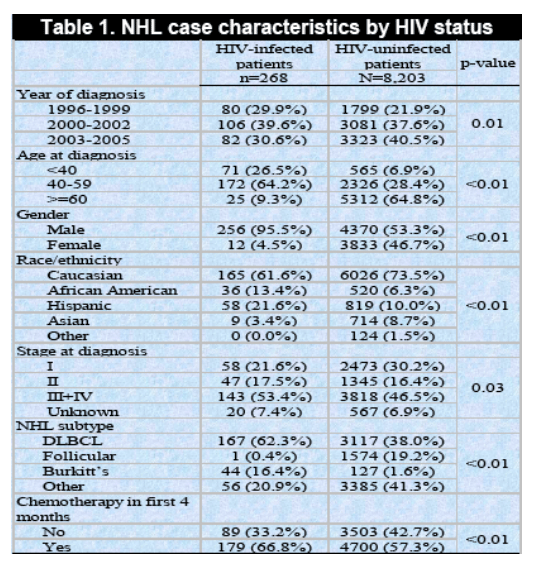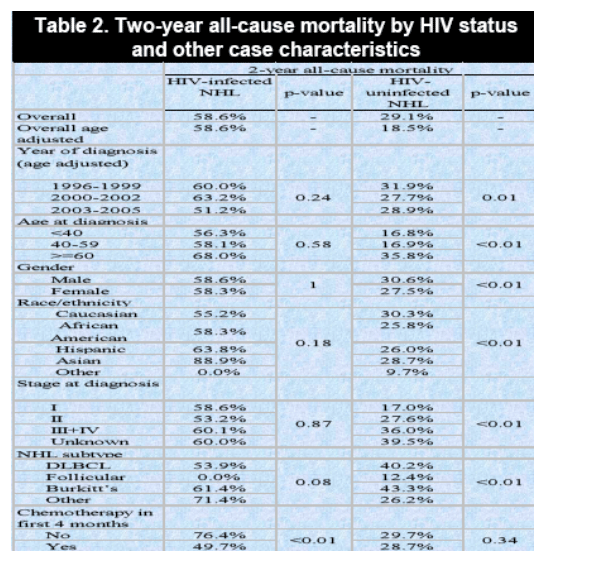 |
 |
 |
| |
Prognosis of Non-Hodgkin's Lymphoma in HIV-infected Patients
|
| |
| |
Reported by Jules Levin CROI 2009 Montreal Feb 8-12
"HIV-1 infected persons with NHL continue to have a significantly higher mortality in ART era. This higher risk does not seem to be limited to certain subtypes or stages. Thus, further research is needed to advance management and therapeutic approaches for NHL in HIV-infected patients."....."HIV status was associated with a significant increase in 2-year mortality"2
The majority of cases
C Chao1, L Xu1, D Abrams2, B Tang1, W Leyden3, M Horberg3, W Towner4, D Klein5, and Michael Silverberg*3
1Kaiser Permanente, Pasadena, CA, US; 2San Francisco Gen Hosp, Univ of California, San Francisco, US; 3Kaiser Permanente, Oakland, CA, US; 4Kaiser Permanente, Los Angeles Med Ctr, US; and 5Kaiser Permanente, Hayward Med Ctr, CA, US2
Background: Previous studies suggest that in the era of HAART, survival of non-Hodgkin's lymphoma in HIV-infected patients has approached that of high grade non-Hodgkin?s lymphoma in HIV-uninfected patients. However, many prior studies had small sample sizes. Our objective was to investigate the association between HIV infection status and 2-year overall mortality in non-Hodgkin?s lymphoma diagnosed in the HAART era.
Methods: We identified 268 HIV-infected and 8203 HIV-uninfected patients diagnosed with non-Hodgkin?s lymphoma between 1996 and 2005 among members of Kaiser Permanente, an integrated health care system serving over 6 million members in California. HIV and non-Hodgkin?s lymphoma status (including diagnosis, stage, histology and initial treatment) were determined using Kaiser Permanente HIV registry and SEER-affiliated cancer registry. All cause mortality was assessed using multiple sources including state death and social security files. The association between HIV status and 2-year overall mortality was examined using multivariable logistic regression with adjustment for age, sex, race/ethnicity, non-Hodgkin?s lymphoma stage, and calendar year of diagnosis. Stratified analyses were conducted for non-Hodgkin?s lymphoma subtypes (i.e., diffuse large B cell lymphoma and Burkitt?s lymphoma), stage at diagnosis, and early (1996-1999) vs. recent (2000-2005) HAART era.
Results: The majority of cases diagnosed with non-Hodgkin?s lymphoma were of clinical stage III and IV in both HIV-infected (53%) and HIV-uninfected (47%) cases. Among HIV-infected cases, 62% were found to be diffuse large B cell lymphoma and 16% were Burkitt?s lymphoma. More than half (59%) of the HIV-infected non-Hodgkin?s lymphoma died within 2 years, compared to 29% in HIV-uninfected cases. Overall, HIV status was associated with a significant increase in 2-year mortality (OR 5.93, 95%CI 4.52 to 7.78). Further adjusting for initial chemotherapy did not change the result. HIV status was also associated with a significant increase in 2-year mortality in diffuse large B cell lymphoma and Burkitt?s lymphomas (OR 2.97 [2.09 to 4.23] and 4.73 [1.66 to 13.56], respectively), and across different stages at diagnosis (OR 8.57 [5.59 to 13.14] for stages I-II and 4.88 [2..92 to 8.15] for stages III-IV). No clear trend was observed from early to recent HAART era (OR 4.84 [2.90 to 8.06] and 6.37 [4.62 to 8.79], respectively).
Conclusions: HIV-infected persons still suffered a significantly higher mortality after non-Hodgkin's lymphoma diagnosis in the HAART era. Further research is needed to advance management and therapeutic approaches for HIV-related non-Hodgkin's lymphoma to improve patient survival.



|
| |
|
 |
 |
|
|